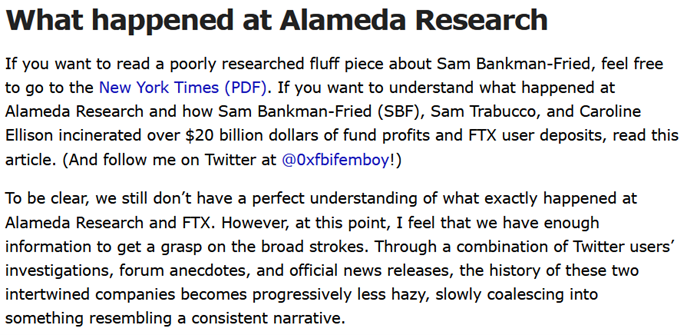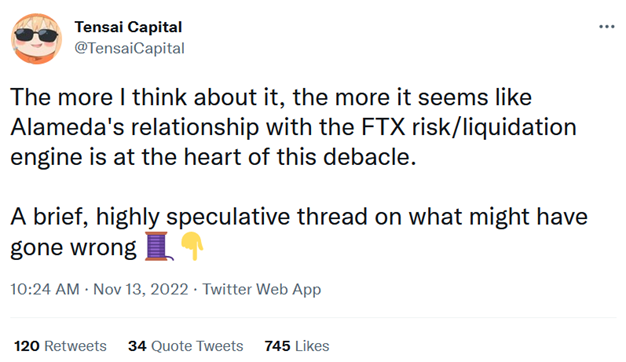SBF's unconvincing and pathetic mea culpa; Four posts/threads about what really happened at FTX and Alameda Research; Silicon Valley Poured Money Into FTX, With Few Strings Attached; Who got it right; Pro pics from the World's Toughest Mudder
1) Yesterday Sam Bankman-Fried ("SBF") posted an 18-tweet thread, attempting to explain what happened at his now-bankrupt crypto entities, FTX and Alameda Research, and how his "one goal is to do right by customers." Pardon me while I gag at this utterly unconvincing and pathetic mea culpa...
The key line here is: "Alameda had more assets than liabilities M2M (but not liquid!)"
In other words, SBF is asserting that FTX filed for bankruptcy because it was illiquid (too many customers wanted cash back immediately) rather than insolvent (losses led to liabilities exceeding assets).
If so, then customers might be made whole if he can raise money or find an acquirer.
This is obvious nonsense, however. Binance wanted to buy FTX, but the moment it looked at its books, it walked away when it saw what has been estimated at a $10 billion hole!
It's clear that FTX suffered huge losses (likely via its affiliated hedge fund, Alameda Research), rendering it insolvent, but SBF covered these losses by stealing customers' money.
That's why I think he's likely to go to prison for 20 years...
2) If you want real insight on what really happened, read these four interesting, detailed posts/threads:
a) Jason Choi:
b) Milky Eggs:
c) Tensai Capital:
d) Doug Colkitt:
3) What I'd like to focus on instead are the important lessons – none more so than the importance of thinking rationally, not getting caught up in hype and bubbles, and doing your own research.
Many of the smartest, most respected investors in the world appear to have forgotten this, as Bloomberg's Matt Levine noted in Monday's missive, quoting from this New York Times article, Investors Who Put $2 Billion Into FTX Face Scrutiny, Too:
"FTX's list of investors spans powerful and well-known investment firms: NEA, IVP, Iconiq Capital, Third Point Ventures, Tiger Global, Altimeter Capital Management, Lux Capital, Mayfield, Insight Partners, Sequoia Capital, SoftBank, Lightspeed Venture Partners, Ribbit Capital, Temasek Holdings, BlackRock, and Thoma Bravo."
I suppose FTX is a failure of venture capitalist due diligence, but it's an odd kind. The usual VC due diligence failure is, like, you back an entrepreneur who promises a futuristic product, and the product doesn't work. FTX worked fine: People liked its technology, and it seems to have made money. The problem was in its balance sheet, which was full of snakes, and its governance, which put all the snakes there. Ideally the venture capitalists would have spotted that in due diligence, but the typical VC company has a very simple balance sheet and terrible governance, so it is sort of understandable that they sailed right by those problems.
Here's a similar story in the Wall Street Journal: Silicon Valley Poured Money Into FTX, With Few Strings Attached. Excerpt:
A marquee roster of investors from Silicon Valley and Wall Street swarmed FTX. They invested nearly $2 billion with few strings attached and no oversight on the cryptocurrency exchange's board, promoting it as a safe bet.
Now the backers are nursing a high-profile black eye as the three-year-old company – valued at $32 billion at its peak – teeters. Venture-capital firm Sequoia Capital said on Wednesday it is writing a $150 million investment one of its funds had in FTX down to zero because of solvency risk.
Lastly, this article that leading venture capital firm Sequoia Capital inexplicably put on its website (Sequoia quickly removed it, but of course someone archived it) makes the folks there look like total fools: Sam Bankman-Fried Has a Savior Complex – And Maybe You Should Too:
Bailhe remembers it the same way: "We had a great meeting with Sam, but the last question, which I remember Alfred asking, was, 'So, everything you're building is great, but what is your long-term vision for FTX?'"
That's when SBF told Sequoia about the so-called super-app: "I want FTX to be a place where you can do anything you want with your next dollar. You can buy bitcoin. You can send money in whatever currency to any friend anywhere in the world. You can buy a banana. You can do anything you want with your money from inside FTX."
Suddenly, the chat window on Sequoia's side of the Zoom lights up with partners freaking out.
"I LOVE THIS FOUNDER," typed one partner.
"I am a 10 out of 10," pinged another.
"YES!!!" exclaimed a third.
What Sequoia was reacting to was the scale of SBF's vision. It wasn't a story about how we might use fintech in the future, or crypto, or a new kind of bank. It was a vision about the future of money itself – with a total addressable market of every person on the entire planet.
"I sit 10 feet from him, and I walked over, thinking, Oh, sh*t, that was really good," remembers Arora. "And it turns out that that f***er was playing League of Legends through the entire meeting."
"We were incredibly impressed," Bailhe says. "It was one of those your-hair-is-blown-back type of meetings"...
The B round raised a billion dollars. Soon afterward came the "meme round": $420.69 million from 69 investors.
This all confirms what I've long believed: Venture capitalists get caught up in bubbles just like the rest of us and end up investing (I use that term loosely) billions of dollars into sketchy companies while doing virtually no due diligence.
4) In sharp contrast to the blue-chip firms listed above (and dozens more), a few lonely voices saw what a total house of cards FTX was. At the top of the list is famed activist short seller Marc Cohodes, who in this in-depth interview only a month ago said that FTX was "dirty and rotten to the core" (skip to 34:40).
The folks at the Doomberg blog interviewed him recently and he said:
I was onto SBF for many months. It just did not add up. I have been around the fraud business for decades, and this guy ticked all the boxes. I handed the story to the head of the Bloomberg Crypto team in London, which consists of 5 people. All of it. They passed on it because they thought it was too hard, too complicated, and might interfere with gaining access to SBF going forward.
Doomberg also highlighted this guy:
One crypto skeptic, citizen journalist, and fellow Substack author nailed the fraud before FTX and Alameda collapsed. Mike Burgersburg is the author of Dirty Bubble Media, where he has published amazing work on various crypto scams. In an outstanding piece published just prior to the collapse titled "Is Alameda Research Insolvent?," Burgersburg laid out the flywheel scheme at the heart of SBF's empire:
"Readers of this site will recall that the now-defunct Celsius Network, a multi-billion dollar crypto lending firm (Ponzi scam) with very close ties to SBF, was destroyed in part by its token, CEL. Celsius Network was built around the CEL token, under the brilliant idea that it could be used to spin up billions of dollars in free assets. The structure of a flywheel scheme is quite simple:
1. Create a token: Tokens are literally just bits of code on a blockchain. Program that sucker up and get rolling. Make sure you retain the majority of those tokens on your balance sheet for maximum flywheeling.
2. Pump the token's price: Retain a 'market maker.' Buy tokens using your customer's assets. Wash trade it to infinity. Do whatever it takes to drive that price sky-high! And since you kept most of the tokens for yourself, there's that many fewer tokens out there to pump.
3. Mark those babies to market: That's right! Now you reap your rewards; at least, on paper. Now you can show billions of dollars in "assets" on your balance sheet.
4. Show off your success: Now's the time to cash in. Hook some savvy investors (suckers), like pension funds, into massively overpaying for your equity or into making you big loans collateralized by your token.
5. Keep that flywheel spinning: Now you have real dollars. Buy yourself something nice, like stadium naming rights, politicians, or failed crypto companies. But don't forget: If the flywheel stops spinning, you're gonna have a bad time."
This is a good lesson on why people should listen to short sellers!
5) At the 24-hour World's Toughest Mudder last weekend – where I did 65 miles and 200-plus obstacles, finishing second in my age group (see my Facebook post here) – there were professional photographers at a number of the obstacles taking photos, and they got some good ones of me. Here are six of them (I posted a dozen more on Facebook here):
Note the different gear I was wearing as the race progressed...
I wore shorts and a T-shirt to start because I was jogging and I didn't want to overheat. But then as the sun went down, the water obstacles opened, and the temperature dropped, I quickly changed into my maximum-warmth gear: a base layer of thick compression 2XU ski tights, a 5mm full-body wetsuit, ski pants/bib and two Arc'teryx Gore-Tex ski jackets (the red one first, then the blue one over it around midnight for the rest of the race), a 3mm neoprene hood (with the jacket hoods pulled up over my head), and Blegg mitts – all of which barely staved off hypothermia, as the nighttime lows hit 33 degrees, it was windy, and I was wet the last 23 hours of the race.
Whitney
P.S. I welcome your feedback at WTDfeedback@empirefinancialresearch.com.





